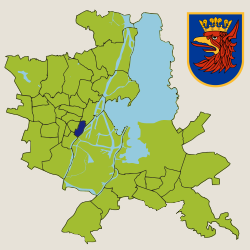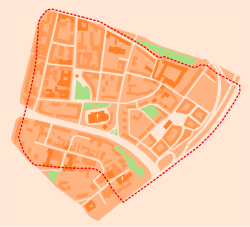This article needs additional citations for verification .(December 2009) |
Old Town Old Town | |
|---|---|
municipal neighbourhood | |
 Old Town at night | |
 Location within Szczecin | |
 Old Town within former city walls | |
| Coordinates: 53°25′42″N14°33′36″E / 53.4284°N 14.5599°E | |
| Country | |
| Voivodeship | West Pomeranian |
| City | Szczecin |
| District | Śródmieście |
| Founded | 1243 |
| Incorporated as a neighbourhood | 1990 |
| Founded by | Barnim I |
| Government | |
| • Body | Neighbourhood council |
| • Council chairman | Małgorzata Zychowicz-Prus |
| Area | |
• Total | 1.1 km2 (0.4 sq mi) |
| Population (2021) [1] | |
• Total | 3,901 |
| • Density | 3,500/km2 (9,200/sq mi) |
| Time zones | UTC+01:00 (UTC) |
| UTC+02:00 (UTC) | |
| Registration plates | ZS |
| Dialling code | +48 91 |
| SIMC code | 0978556 |
| Website | staremiasto |
Old Town (Polish: Stare Miasto; German: Altstadt), and the core of the historic old German port city of Stettin until 1950, is a municipal neighborhood of the modern city of Szczecin, now in Poland, situated on the left bank of the Oder river. It is the oldest historical district in the city. As of March 2021 it had a population of 3,901. [1]
